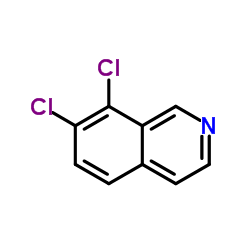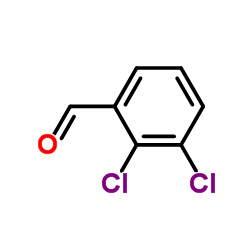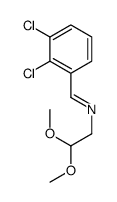Isoquinoline, 7,9-dichloro-1,2,3,4-tetrahydro-
Modify Date: 2024-01-02 15:13:41

Isoquinoline, 7,9-dichloro-1,2,3,4-tetrahydro- structure
|
Common Name | Isoquinoline, 7,9-dichloro-1,2,3,4-tetrahydro- | ||
|---|---|---|---|---|
| CAS Number | 61563-24-4 | Molecular Weight | 202.08000 | |
| Density | 1.293g/cm3 | Boiling Point | 310.7ºC at 760 mmHg | |
| Molecular Formula | C9H9Cl2N | Melting Point | N/A | |
| MSDS | N/A | Flash Point | 141.7ºC | |
Use of Isoquinoline, 7,9-dichloro-1,2,3,4-tetrahydro-7,8-Dichloro-1,2,3,4-tetrahydroisoquinoline (compound 11), a tetrahydroisoquinoline (THIQ) derivative, is a selective phenylethanolamine N-methyltransferase (PNMT) inhibitor with a Ki value of 0.3 μM. 7,8-Dichloro-1,2,3,4-tetrahydroisoquinoline can be used in research on psychiatric disorders related to Alzheimer's disease and Parkinson's disease[1]. |
| Name | 7,8-dichloro-1,2,3,4-tetrahydroisoquinoline |
|---|---|
| Synonym | More Synonyms |
| Description | 7,8-Dichloro-1,2,3,4-tetrahydroisoquinoline (compound 11), a tetrahydroisoquinoline (THIQ) derivative, is a selective phenylethanolamine N-methyltransferase (PNMT) inhibitor with a Ki value of 0.3 μM. 7,8-Dichloro-1,2,3,4-tetrahydroisoquinoline can be used in research on psychiatric disorders related to Alzheimer's disease and Parkinson's disease[1]. |
|---|---|
| Related Catalog | |
| In Vivo | 7,8-Dichloro-1,2,3,4-tetrahydroisoquinoline (SKF-64139) (i.p., 40 mg/kg, once daily, 3 days) has an important role in the regulation of blood pressure and changes in adrenal catecholamine levels in rats[2]. Animal Model: Male spontaneously hypertensive (SHR) and their age-paired normotensive Wistar-Kyoto (WKY) rats[2] Dosage: 40 mg/kg Administration: i.p.; once daily; 3 days Result: Caused a decrease in blood pressure in SHR rats but no effect on blood pressure in WKY rats. Caused a decrease in hypothalamic epinephrine (Epi) levels, norepinephrine (NE) levels and raised dopamine (DA) levels in both SHR and WKY rats. |
| References |
| Density | 1.293g/cm3 |
|---|---|
| Boiling Point | 310.7ºC at 760 mmHg |
| Molecular Formula | C9H9Cl2N |
| Molecular Weight | 202.08000 |
| Flash Point | 141.7ºC |
| Exact Mass | 201.01100 |
| PSA | 12.03000 |
| LogP | 2.96790 |
| Index of Refraction | 1.574 |
| HS Code | 2933499090 |
|---|
|
~% 
Isoquinoline, 7... CAS#:61563-24-4 |
| Literature: Bondinell; Chapin; Girard; Kaiser; Krog; Pavloff; Schwartz; Silvestri; Vaidya; Lam; Wellman; Pendleton Journal of Medicinal Chemistry, 1980 , vol. 23, # 5 p. 506 - 511 |
|
~% 
Isoquinoline, 7... CAS#:61563-24-4 |
| Literature: Bondinell; Chapin; Girard; Kaiser; Krog; Pavloff; Schwartz; Silvestri; Vaidya; Lam; Wellman; Pendleton Journal of Medicinal Chemistry, 1980 , vol. 23, # 5 p. 506 - 511 |
|
~% 
Isoquinoline, 7... CAS#:61563-24-4 |
| Literature: Bondinell; Chapin; Girard; Kaiser; Krog; Pavloff; Schwartz; Silvestri; Vaidya; Lam; Wellman; Pendleton Journal of Medicinal Chemistry, 1980 , vol. 23, # 5 p. 506 - 511 |
| HS Code | 2933499090 |
|---|---|
| Summary | 2933499090. other compounds containing in the structure a quinoline or isoquinoline ring-system (whether or not hydrogenated), not further fused. VAT:17.0%. Tax rebate rate:13.0%. . MFN tariff:6.5%. General tariff:20.0% |
| 7,8-Dichlor-1,2,3,4-tetrahydroisochinolin |
| 1yz3 |
| 7,8-Dichloro-1,2,3,4-tetrahydroisoquinoline |
| SK&SKA |


